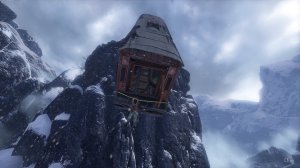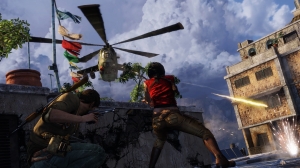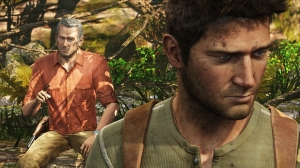Naughty Dog has come a long way over the years. The studio first gained widespread recognition with the Crash Bandicoot franchise, of which they developed the entries found on the original Sony Playstation. The Playstation 2 era saw Naughty Dog make a more serious platforming series with Jak & Daxter, while the Playstation 3 years saw them reach new critical heights with The Last of Us and the Uncharted series.
Naughty Dog has now broken their usual conventions by resurrecting one of their series for a new Playstation generation, as the Playstation 4 is now home to the fourth entry of the Uncharted series, which Naughty Dog has claimed will be its final installment before they head into new horizons. If Uncharted 4: A Thief’s End really is the last hoorah for Nathan Drake and co., they probably couldn’t ask for a better sendoff. Uncharted 4 is both a culmination of everything Uncharted has accomplished over the last nine years, and a loving tribute to Naughty Dog’s own history.
 Uncharted 4 sees series hero Nathan Drake in a new light, as he’s put his adventuring life behind him, settled down, and married series heroine Elena Fisher. But when Nathan Drake’s older brother Sam – long believed to be dead – comes back into Nathan’s life, our hero is left with little choice but to resume his dangerous lifestyle.
Uncharted 4 sees series hero Nathan Drake in a new light, as he’s put his adventuring life behind him, settled down, and married series heroine Elena Fisher. But when Nathan Drake’s older brother Sam – long believed to be dead – comes back into Nathan’s life, our hero is left with little choice but to resume his dangerous lifestyle.
It turns out that Sam Drake has been locked away in a South American prison for the last fifteen years. Though Sam hasn’t seen the same kinds of adventures as his younger brother, he does share a similar love for adventure, being most obsessed with the lost treasure of the legendary pirate Captain Henry Every (spelled “Avery” in the game). Sam has deduced where to begin searching for the treasure, but made the grave mistake of sharing this information with his cellmate, a notorious drug lord named Alcazar. After Alcazar enacts a prison break, he threatens Sam to find Avery’s treasure for him, giving Sam mere months to do so before Alcazar’s men come looking for him.
 Sam, aware of his brother’s famous exploits, tracks down Nathan Drake, who reluctantly agrees to partake in the treasure hunt to save his brother’s life (after believing to have lost his brother once, Nate can’t bear the thought of losing him again). The brothers recruit Nathan Drake’s old friend Victor “Sully” Sullivan, and the three of them head out on their biggest adventure yet. But things won’t be so easy, as an old rival of the Drakes, Rafe Adler, and his army-for-hire, will stop at nothing to get the treasure first.
Sam, aware of his brother’s famous exploits, tracks down Nathan Drake, who reluctantly agrees to partake in the treasure hunt to save his brother’s life (after believing to have lost his brother once, Nate can’t bear the thought of losing him again). The brothers recruit Nathan Drake’s old friend Victor “Sully” Sullivan, and the three of them head out on their biggest adventure yet. But things won’t be so easy, as an old rival of the Drakes, Rafe Adler, and his army-for-hire, will stop at nothing to get the treasure first.
 The premise is simple enough, but it serves as a perfect setup for Nathan Drake and company to visit the most exotic locations and partake in the most tremendous action set pieces in the series. The story also provides the series’ best character development, with Nathan, Sam, Sully and Elena all growing as characters, and Rafe proving to be the series’ best villain.
The premise is simple enough, but it serves as a perfect setup for Nathan Drake and company to visit the most exotic locations and partake in the most tremendous action set pieces in the series. The story also provides the series’ best character development, with Nathan, Sam, Sully and Elena all growing as characters, and Rafe proving to be the series’ best villain.
Where Uncharted 4 shines the brightest, however, is in its gameplay. Taking the best elements of its three predecessors – and a few cues from Naughty Dog’s other works – Uncharted 4 is the most polished and varied entry in the series.
Nathan Drake is still able to equip two guns at a time (a pistol and a larger weapon) for a bit of run-and-gun, third-person shooting, and there’s still plenty of platforming and climbing to be had. And yes, there are still Indiana Jones style puzzles to be solved from time to time. What makes Uncharted 4 feel refreshing, despite being the fourth entry in the series, is how well utilized these elements are.
The staging and level design in Uncharted 4 brings out the best of the series’ elements. The combat and platforming feel more fluid than ever, and the puzzles are easily the best in the series, with some of them requiring some serious thinking to solve.
Unfortunately, there are still a handful of shootout segments that are overly long (a complaint I had with previous entries that really seems like it should have been rectified by this point), but they are much less excessive than they were in the third entry. It’s never that these shootout segments are outright bad (a point I might argue was the case in Uncharted 3), but Uncharted is at its best when it’s utilizing all three of its gameplay components: shooting, platforming and puzzles. So when the shooting segments do become a bit excessive, it becomes really noticeable, and can take away from some of the game’s overall genius with their repetition.
 That’s ultimately a small complaint, however, when you take into account how well the overall package is, especially the series’ famous set pieces, which reach new heights with their exhilarating pace and ridiculous setups. From taking part in a gunfight while dangling from a collapsed building over a cliff to the series’ best car chase sequence to booby-trap-filled pirate islands, Uncharted 4 keeps upping the ante with one action achievement after another.
That’s ultimately a small complaint, however, when you take into account how well the overall package is, especially the series’ famous set pieces, which reach new heights with their exhilarating pace and ridiculous setups. From taking part in a gunfight while dangling from a collapsed building over a cliff to the series’ best car chase sequence to booby-trap-filled pirate islands, Uncharted 4 keeps upping the ante with one action achievement after another.
A small gameplay twist has been added to the game’s narrative, as there are a number of instances in which players are given a series of choices for how Nathan Drake reacts to a situation and what he has to say. It’s nothing game-changing, and maybe even a bit under-utilized, but it does help give the game an added dose of personality (not that it had any shortage in that department).
 Another of the game’s highlights is the presentation. Good heavens, is this game ever gorgeous! From a purely technical standpoint, Uncharted 4 might be the best looking game I’ve ever seen. Every environment is richly detailed, and a wonder to behold. The character models and animations are the most realistic I’ve seen in a game, made all the more believable by the great performances of the actors. The cinematic presentation is simply second to none.
Another of the game’s highlights is the presentation. Good heavens, is this game ever gorgeous! From a purely technical standpoint, Uncharted 4 might be the best looking game I’ve ever seen. Every environment is richly detailed, and a wonder to behold. The character models and animations are the most realistic I’ve seen in a game, made all the more believable by the great performances of the actors. The cinematic presentation is simply second to none.
The campaign alone would be more than enough, but Naughty Dog has gone the extra mile and included an incredibly fun and addicting multiplayer mode to go with it. Teams of players can face off against each other in a handful of play styles (from death matches to capture the flag, under the title of “Idols”).
 The seemingly simple multiplayer setup turns into something great due in large part to how well it implements the core mechanics from the main game, and tweaks them appropriately for multiple players. Along with the usual platforming and shooting, players can gain upgrades and power-ups by collecting treasure (obtained via defeating enemies, helping downed allies, or finding trinkets throughout the stages). With enough treasure, players can purchase better weapons, AI controlled henchmen (like brutes, medics and snipers), and powerful items called “Mystics,” which pay homage to the supernatural twists of the series by unleashing curses on your foes or giving benefits to your team.
The seemingly simple multiplayer setup turns into something great due in large part to how well it implements the core mechanics from the main game, and tweaks them appropriately for multiple players. Along with the usual platforming and shooting, players can gain upgrades and power-ups by collecting treasure (obtained via defeating enemies, helping downed allies, or finding trinkets throughout the stages). With enough treasure, players can purchase better weapons, AI controlled henchmen (like brutes, medics and snipers), and powerful items called “Mystics,” which pay homage to the supernatural twists of the series by unleashing curses on your foes or giving benefits to your team.
 Uncharted 4: A Thief’s End is a wonderful gaming experience that exudes a strong sense of love and dedication on the part of its developers. That main adventure captures the feeling of an action-adventure flick better than any game out there, and the multiplayer is strong enough to hold its own. Take into account that the campaign’s hidden treasures, notes, and secret dialogues are more cleverly tucked away this time around and require some serious exploration to unearth, and that you can unlock customizable options for the multiplayer modes (from small costume changes to additional characters from the series’ history), and you have more than enough content to keep you coming back for more.
Uncharted 4: A Thief’s End is a wonderful gaming experience that exudes a strong sense of love and dedication on the part of its developers. That main adventure captures the feeling of an action-adventure flick better than any game out there, and the multiplayer is strong enough to hold its own. Take into account that the campaign’s hidden treasures, notes, and secret dialogues are more cleverly tucked away this time around and require some serious exploration to unearth, and that you can unlock customizable options for the multiplayer modes (from small costume changes to additional characters from the series’ history), and you have more than enough content to keep you coming back for more.
Some of the series’ flaws are still present, and the new mechanics that are added aren’t as present as they could have been, but Uncharted 4: A Thief’s End is no doubt a milestone for Naughty Dog. In one segment of the game, Nathan Drake plays one of the stages from the original Crash Bandicoot on his Playstation. This moment doesn’t just play into our nostalgia, but also sums up what Uncharted 4 is all about. This isn’t just Nathan Drake’s last ride, it’s also a culmination of Naughty Dog’s accomplishments that started over two decades ago, on the shoulders of a bandicoot.









